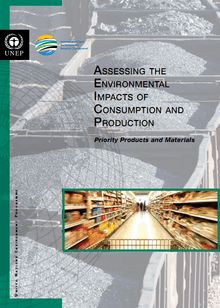Priority Products and Materials report
 | |
| Type | Independent scientific assessment |
|---|---|
| Publication | June 2010, International Resource Panel |
| Website | IRP Publications |
The report Priority Products and Materials: Assessing the Environmental Impacts of Consumption and Production is one of a series of scientific assessments published by the International Resource Panel (IRP) of the United Nations Environment Programme (UNEP). The IRP provides independent scientific assessments and expert advice on a variety of areas, including:
• the volume of selected raw material reserves and how efficiently these resources are being used
• the lifecycle-long environmental impacts of products and services created and consumed around the globe
• options to meet human and economic needs with fewer or cleaner resources.
About the report
The report assessed the impacts of economic activities on the Earth's natural environment. It identified that the most critical impacts are related to ecosystem health, human health and resource depletion. From a combined production, consumption and materials perspective, the authors found that the production of food and all processes involving fossil fuels had the greatest impacts. Animal products caused more damage than producing construction minerals such as sand or cement, plastics or metals. Currently, more than half the world's crops are used to feed animals. In America, more than one-third of the fossil fuels produced are used to raise animals for food.[1]
The authors explained that Western dietary preferences for meat would be unsustainable as the world population rose to the forecast 9.1 billion by 2050. Demand for meat is expected to double by this date; meat consumption is steadily rising in countries such as China that once followed more sustainable, vegetable-based diets.
References
- ↑ New UN Report Says Vegan Diet Vital To Saving The Environment, Curbing Fossil Fuel Use, Care2 Make a Difference, 3 June 2010